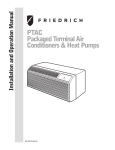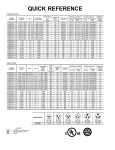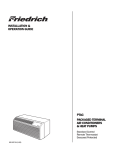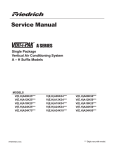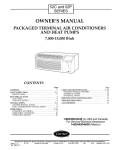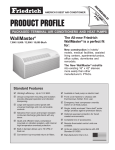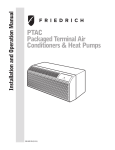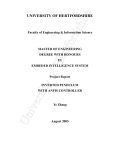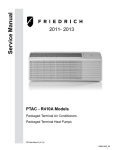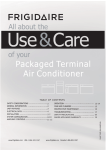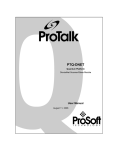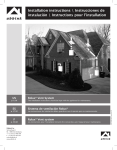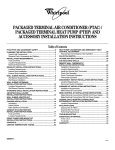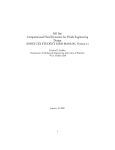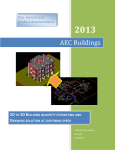Download Friedrich WallMaster PTAC User's Manual
Transcript
WallMaster ® PTAC
Packaged Terminal Air Conditioners & Heat Pumps
• Standard
• Remote Thermostat
• Seacoast Protected
Installation & Operation Manual
920-087-02 (9-03)
920-087-02 (9-03)
Table of Contents
Unit Components .........................................................................................................................................................................................2
P-Series Announcement/Model Number Code............................................................................................................................................3
Installation Recommendations....................................................................................................................................................................4
Drain Kit Installation ................................................................................................................................................................................5-6
Wall Sleeve Installation............................................................................................................................................................................ 7-8
Deep Wall Installation..................................................................................................................................................................................9
Standard Grille Installation........................................................................................................................................................................10
Installation Checklist .................................................................................................................................................................................11
Electrical Rating Tables..............................................................................................................................................................................11
Chassis Installation ............................................................................................................................................................................. 12-13
Standard Unit Operations ..........................................................................................................................................................................14
Temperature Limiting Thermostat ..............................................................................................................................................................14
Heating Control (Heat Pumps & Emergency Heat)..................................................................................................................................... 15
Fan Cycle Switch ....................................................................................................................................................................................... 15
Fresh Air Vent Control................................................................................................................................................................................ 15
Air Discharge Grille ....................................................................................................................................................................................16
Start-up Checklist......................................................................................................................................................................................16
Appendix A: Remote Thermostat Wiring ...............................................................................................................................................17-18
Appendix B: Electrical Wiring for 265 V Models........................................................................................................................................ 19
Routine Maintenance................................................................................................................................................................................ 20
Basic Troubleshooting Techniques .............................................................................................................................................................21
Accessories .........................................................................................................................................................................................22-23
Warranty ................................................................................................................................................................................................... 24
Typical Unit Components
Outdoor grille
Wall sleeve
Chassis
Front cover
2
920-087-02 (9-03)
Announcing the Friedrich P-Series Packaged Terminal Air Conditioner.
A new approach to reliability and efficiency. A totally redesigned Friedrich PTAC.
Thank you for your decision to purchase the newly designed Friedrich Packaged Terminal Air Conditioner
(PTAC). We are confident that you will find this unit a quiet and efficient example of Friedrich reliability.
This Installation and Operation Manual has been designed to insure maximum satisfaction in the performance
of your unit. For years of trouble-free service, please follow the installation instructions closely. We cannot
overemphasize the importance of proper installation. We have added new information to the basic instructions
to help you achieve success.
Remember, proper installation is not difficult but it is essential.
Model Number Code
P H 07 K 3 S A 1
Engineering Digit
Series
P = P series
Design Series
Options
S = Standard
R = Remote Thermostat
C = Seacoast Protection
X = Remote Thermostat and
Seacoast Protection
System
X= Accessory
E= Cooling with or
without electric heat
H =Heat Pump with
Auxiliary Heat
Nominal Cooling Capacity
07 =
7,000
09 =
9,000
12 =
12,000
15 =
15,000
Btuh
Btuh
Btuh
Btuh
Nominal Heater Size
(@ 230V or 265V)
0 = No Heater
2 = 2.5 KW
3 = 3.4 KW
5 = 5.0 KW
Voltage
K = 230/208V - 1 Ph. - 60 Hz.
R = 265V - 1 Ph. - 60 Hz.
Please read this manual thoroughly prior to equipment installation or operation. It is the installer’s responsibility
to properly apply and install the equipment. Installation must be in conformance with the NFPA 70-2002
National Electric Code or current edition and Universal Mechanical Code current edition and applicable local
or national codes.
3
920-087-02 (9-03)
PTAC Installation Recommendations
For proper PTAC unit performance and maximum operating life please refer to the minimum installation clearances below:
Figure 1
PTAC units should be installed
no closer than 12" apart when
two units are side by side. If
three of more PTAC units are to
operate next to one another allow
a minimum of 36" between units.
Also, a vertical clearance of 60"
should be maintained between
units installed.
THREE OR MORE PTACs
ADJACENT 36" MINIMUM
VIEW: OUTSIDE
BUILDING ELEVATION
TYP.
WINDOW
36"
TWO ADJACENT
PTACs 12" MINIMUM
60"
60" VERTICAL MIMUMUM
BETWEEN PTACs
GROUND FLOOR PTACs
6" MINIMUM FROM GRADE
12"
6"
Figure 2
For PTACs on the ground floor or anytime obstructions are present, use the following guidelines:
• For minor obstructions
such as lamp poles or small
shrubbery a clearance of
12" from the outdoor louver
should be maintained.
• For major obstructions such
as a solid fence, wall or
other heat rejecting device
like a condensing unit, a
minimum distance of 36"
should be kept.
TYP. BUILDING ( PLAN VIEW )
36"
36"
PTAC
PTAC
PTAC
12"
12" MINIMUM, MINOR
OBSTRUCTIONS
36" MIMUMUM, MAJOR
OBSTRUCTIONS
POLE
36"
SHRUB
FENCE OR WALL
CONDENSING UNIT
The above suggestions are for reference only and do not represent all possible installations. Please contact the factory
for information regarding affects of other installation arrangements. By following these simple recommendations you
can be confident that your Friedrich PTAC will provide years of worry free operation.
4
920-087-02 (9-03)
Installation Instructions PXDR10 Drain Kit
NOTE: Determine whether drain will be located within the wall, on the indoor side, or will drain to the exterior of the building. Follow
appropriate instructions below depending on your particular type of installation.
Internal Drain (optional for new construction)
NOTE: If installing an internal drain, you MUST install a drain kit on
the wall sleeve before the wall sleeve is installed.
1.
Refer to Figure 3 below and locate the drain within the
"Primary" area for best drainage. Maintain at least a 1/2"
clearance from the embossed area.
2.
Using the mounting plate with the 1/2" hole as a template,
mark and drill two, 3/16" mounting holes and a 1/2" drain
hole.
3.
Remove the backing from the gasket and mount it on the flat
side of the mounting plate. (See Figure 4.) Insert the drain
tube through the hole in the gasket and mounting plate so
the tube flange will be against the wall sleeve.
4.
Position the assembly beneath the drilled holes and secure
it with #10-24 x 1/2" machine screws and lock nuts provided.
Seal the tops of the screws with silicone caulking.
5.
Use 1/2" I.D. copper tube, PVC pipe, or vinyl hose (obtained
locally) to connect the internal drain tube to the drain system
in the building.
6.
Referring to Detail A on page 6, locate and assemble the
(2) two cover plates and gaskets over the drain holes at the
rear of the wall sleeve. Attach them with the #10 sheet metal
screws provided. Make certain that the four overflow slots at
the rear of the wall sleeve are not blocked (See drawing of
the back of the sleeve on page 6).
7.
If a deep wall extension (PXWE) is used, after installing the
field supplied flashing, caulk as required. Be sure to caulk
around the flashing and the wall sleeve where the hole was
drilled for the drain tube.
Figure 3
Drain Kit Location and Installation
Secondary area
Primary area - no foam insulation
If the drain must be located in the
secondary area, the foam insulation
must be cut away and removed to
allow access to the drain.
3"
7.6 cm
Screw
Wall sleeve
Gasket
Mounting plate
Nut
Drain tube
5
920-087-02 (9-03)
External Drain (for new construction or unit replacement)
When using an external drain system, the condensate is removed through either of two drain holes on the back of the wall sleeve. Select
the drain hole which best meets your drainage situation and install the drain kit. Seal off the other with a cover plate.
Drain Tube Installation
Cover Plate Installation
1.
Peel the backing tape off the gaskets and apply the sticky
side to one cover plate and one mounting plate as shown
in Details A and B.
2.
Place the drain tube through the gasket and the mounting
plate with the flange toward the wall sleeve.
3.
Attach the drain tube assembly to one of the two drain
holes at the rear of the wall sleeve. The large flange on
the mounting plate is positioned at the bottom of the sleeve
facing toward the sleeve, Detail B. When the drain tube is
positioned at the desired angle, tighten the screws.
NOTE: If the wall sleeve has not been installed, the drain tube must
be rotated to a horizontal position until after the sleeve
is installed. Tighten the mounting plate screws when the
tube is in the proper position. Make certain that the four
overflow slots at the rear of the wall sleeve are not blocked.
(See the drawing below.)
4.
Mount the foam gasket to the cover plate. Using two #10 x
1/2" sheet metal screws (provided), attach the cover plate
to the remaining drain hole. Make certain the large flange
on the plate is positioned at the bottom of the sleeve.
5.
Discard the additional cover plate, gasket, machine screws,
and locknuts.
PXDR1O
QUANTITY
2
1
1
3
4
2
2
DESCRIPTION
COVER PLATES
MOUNTING PLATE
DRAIN TUBE
MOUNTING PLATE GASKETS
#10 X 1/2" MOUNTING SCREWS
10-24 X 1/2" MACH. SCREWS
LOCKNUTS
Figure 4
Drain Kit Installation
Foam gasket
Mounting plate
DETAIL A
Foam gasket
/2" O.D. tube
1
Mounting plate
#10 sheet metal screws
DETAIL B
NOTES:
The large flange on the mounting plate is positioned at the bottom of the sleeve facing toward the sleeve. The drain tube must be rotated to a horizontal
position to allow for the wall sleeve to be installed into the wall. Once the wall sleeve is installed, return the drain tube to a downward angle.
6
920-087-02 (9-03)
Wall Sleeve Installation Instructions (PXWS)
NOTE: Insure that the unit is only installed in a wall structurally adequate to support the unit including the sleeve, chassis and accessories.
If the sleeve projects more than 8" into the room, a subbase or other means of support MUST be used. Please read these instructions
completely before attempting installation.
Figure 5
Typical Wall Sleeve Installation
.
Lintel to support masonry walls
in
1⁄4" m
42 cm)
3
.
07
161⁄4"
(41.3 cm)
(1
m)
7c
2
" (1
n.
mi
Electrical receptacle
50
Insulation
10"
(25.4 cm)
max.
1
(34 33⁄4"
.9 c
m)
Electrical receptacle
Wall opening
Wall sleeve
Insulation
Smooth side of screw
clip facing into room
For Deep Wall Installation See Section II
The following instructions apply ONLY to walls less than
13 1/4" in depth.
1.
From inside the building, position the wall sleeve in the opening
and push it through the wall so it protrudes at least 1/4" on the
outside, note Figure 5.
2.
Position the wall sleeve with a slight tilt towards the outside to
facilitate condensate drainage. It should be level side-to-side
and the front should be 1/4 bubble higher than the back. DO
NOT allow any pitch toward the inside.
Electrical shock hazard.
Turn electric power OFF at the fuse box or service panel
before making any electrical connections and ensure a
proper ground connection is made before connecting line
voltage. Failure to do so can result in property damage,
personal injury and/or death.
7
920-087-02 (9-03)
Figure 6
Dimensions
1⁄4"
(6.4 cm)
min.
A
Dimension*
Min.
Max
1⁄4"
(6.4 mm)*
1⁄4"
(6.4 mm)
---
With Subbase
13⁄4"
(4.5 cm)
31⁄2"
(8.9cm)
5"
(12.7cm)
With Lateral Duct
3⁄4"
(1.9 cm)
1⁄4"
(6.4 mm)
---
B
Wall
3.
Drill two 3/16" holes through each side of the sleeve
approximately 4" from top and 4" from bottom of sleeve. Screw
four #10 x 1" screws (included) or appropriate fasteners for your
installation, through the holes in the sides of the wall sleeve.
4.
Apply sealant around the wall sleeve where it projects through
the inside and outside wall surfaces. Apply the sealant to the
screw heads or the tops of the fasteners used in Step #3.
B
Allow for floor finishing
(Minimum)
No Accessories
133⁄4 "
(35 cm)
A
Allow
for wall
finishing
* If more than one accessory is to be used, use the maximum
dimension. If the wall thickness is more than 133⁄4" (35cm) (A + 1⁄4" [6.4 mm]), a sleeve extension must be used.
5.
If the chassis and exterior grille are to be installed later, leave the
weatherboard and center support in place, otherwise remove
and dispose of them.
6.
Provide a support lintel if the wall sleeve is installed in a concrete
or masonry wall. (See Figure 7.)
NOTE: When sealing the sleeve on the outside of the building,
be careful NOT to let the sealant block the two condensate
drain holes or the four overflow slots at the bottom flange of
the sleeve.
Figure 7
Lintel Installation
Main studs
Jack studs
Lintel
Main studs
Jack studs
Mounting screw holes
No holes in bottom of wall
sleeve unless drain kit is used
NOTE: Construct wall opening to comply with all applicable
building codes.
8
920-087-02 (9-03)
Section II — Deep Wall Installation (PXWE)
If the wall is thicker than allowed in the notes in Figure 6, a sheet
metal wall sleeve extension and flashing MUST be used.
Installation Instructions for the PXWE – 4" Wall Sleeve
Extension
The following points MUST be considered when installing a wall
sleeve extension:
1 Provision must be made to direct excess condensate from
the back of the wall sleeve into the extension then outside
the building or to a drainage system.
2. Air baffles must be mounted to properly direct air flow to and
from the condenser.
3. The wall sleeve extension design must allow for the proper
mounting of the grille.
4. Caulking is required at all sites where condensate or external
water could potentially infiltrate into the building.
6. Condensate notches and overflow slots must be kept clear
of sealant and gaskets so condensate can flow freely into the
wall sleeve extension.
NOTE: Improper fabrication or installation of a wall sleeve extension
will impair PTAC performance.
Extension Installation
Secure the wall sleeve extension to the wall sleeve before installing
it in the wall. Refer to Figure 8 for a guide for fabrication of a
condensate drip panel. The panel MUST extend the full depth of
the wall sleeve and the wall sleeve extension.
Pay particular care in sealing and caulking the panel where it makes
contact with the wall sleeve (see Figure 8). After installation in the
wall, secure with fasteners through the sides. Use a good grade
of silicone sealant around the sleeve extension. Seal all exposed
screw heads. When the installation is complete, the outside grille
should be attached to the wall sleeve extension.
5. Fabricate and install metal flashing in wall to serve as a drip
panel. Refer to drawing for more information.
Figure 8
Wall Sleeve Extension Sealant Locations
IMPORTANT NOTE: The silicone bead MUST extend 3"
up the side of the two flanges to prevent condensate
from leaking.
Wall Sleeve
Outside Edge
Insulation
Air Baffles
Sealant inside (4) bottom corners
Width of Wall
Drip
Edge
Condensate
Drip Panel
(Field
Supplied)
Condensate
Notches (4)
Wall Sleeve Extension, 42" X 16" Frame, 20 gauge minimum, painted or aluminium
PXWE Wall Sleeve
Extension
9
920-087-02 (9-03)
Installation Instructions Model PXGA Standard Grille
1. Remove the center support and weatherboard if still installed
in the sleeve.
2. Insert six plastic grommets into the grille openings from the
outside of the grille as shown in Figure 9.
3. Insert two #8 x 3/8" sheet metal screws (provided) in the top
two outside edge plastic grommets, and tighten them half way
into the grommets.
5. Grasp the grille by the attached plastic handles. Position it with
the condensate drain knockouts facing down. From inside the
building, maneuver the grille through the wall sleeve and pull
toward you until the screw heads are inserted into the keyhole
slots at the top of the wall sleeve. Tighten the two screws
completely.
6. Insert the remaining screws into the remaining holes and
tighten securely.
4. CAUTION: Bodily injury can be caused by grilles falling from
a building during installation. It is recommended that a safety
line be attached to the grille and an anchor point inside the
building during installation.
Figure 9
PXGA
Quantity
1
6
6
Description
Stamped Aluminum Grille
Plastic Grommets
#8 x 3/8" Sheet Metal Screws
Figure 9
Standard Grille
Wall sleeve
Weatherboard
Center support
Plastic handles
10
Plastic
grommets
920-087-02 (9-03)
A. Installation Checklist
o
Inspect all components and accessories for damage
before and after installation.
o
Install the recommended Condensate Drain Kits for
complete condensate removal.
o
Remove the cardboard wall sleeve support and grille
weatherboard.
o
o
Check for proper wall sleeve installation in accordance
with the wall sleeve installation instructions.
Ensure that the chassis is installed in a 16" high x 42" wide
wall sleeve that is no deeper than
13 3/4". A baffle kit is required if the sleeve exceeds that
depth.
o
Ensure that drapes, bed, bedspread, furniture, etc. DO
NOT block either return or discharge air grilles.
o
Inspect the condenser air inlet and outlet for any
obstructions (shrubbery, etc.)
o
o
Check installation of the wall sleeve foam gasket.
Check for a subbase kit or other means of structural
support which is required for ALL installations projecting
more than 8" into room.
B. Electrical Rating Tables
All 230/208 volt units are equipped with power cords. See Appendix B on page 19 for wiring instructions on 265V units.
NOTE: Use Copper Conductors ONLY. Wire sizes are per NEC, check local codes for overseas applications.
Table 1
Table 2
250 V Receptacles and Fuse Types
AMPS
15
20 *
Nameplate
maximum circuit breaker size
15
30
RECEPTACLE
MANUFACTURER
Hubbell
P&S
GE
Arrow-Hart
TIME-DELAY TYPE FUSE
(or HACR circuit breaker)
PART NUMBERS
5661
5661
GE4069-1
5661
5461
5871
GE4182-1
5861
9330
5930
GE4139-3
5700
15
20
30
Recommended branch circuit wire sizes*
AWG Wire size**
14
20
12
30
10
AWG – American Wire Gauge
* Single circuit from main box
** Based on copper wire, single insulated conductor at 60°C
HACR – Heating, Air Conditioning, Refrigeration
* May be used for 15 Amp applications if fused for 15 Amp
NOTE: 265 volt units are hard wired.
Electric shock hazard.
Turn off electric power before service or installation.
All electrical connections and wiring MUST be installed by a qualified electrician and
conform to the National Electrical Code and all local codes which have jurisdiction.
Failure to do so can result in property damage, personal injury and/or death.
Wire Size
Use ONLY wiring size recommended for single outlet branch circuit.
Fuse/Circuit
Breaker
Use ONLY type and size fuse or HACR circuit breaker indicated on unit’s rating plate. Proper current protection to the unit is the responsibility of the
owner. NOTE: A time delay fuse is provided with 265V units.
Grounding
Unit MUST be grounded from branch circuit through service cord to unit, or through separate ground wire provided on permanently connected units.
Be sure that branch circuit or general purpose outlet is grounded. The field supplied outlet must match plug on service cord and be within reach of
service cord. Refer to Table 1 for proper receptacle and fuse type. Do NOT alter the service cord or plug. Do NOT use an extension cord.
Receptacle
The field supplied outlet must match plug on service cord and be within reach of service cord. Refer to Table 1 for proper receptacle and fuse type.
Do NOT alter the service cord or plug. Do NOT use an extension cord.
Wire Sizing
Use recommended wire size given in Table 2 and install a single branch circuit. All wiring must comply with local and national codes. NOTE: Use
copper conductors only.
11
920-087-02 (9-03)
Section III – Chassis Installation
* Check to be sure the wall sleeve, extension (if used), grille, and drain kit are installed properly before
chassis installation
1. Remove the weatherboard and center support from
the sleeve (if still in place). Be sure an outdoor grille is
attached.
NOTE: To avoid breaking the door or hinge pins, do not apply
excessive force when installing
2
1
Pins
Wall sleeve
Control
Door
Weatherboard
Front Panel
Center support
IMPORTANT: Use a wall sleeve adapter kit (PXSE) if
installing a P-Series chassis in a T-Series sleeve.
3. Remove the two chassis shipping brackets from the ends of
the shipping pallet.
3
Compressor
Chassis
shipping bracket
Suffocation hazard
Keep bag away from babies and children.
Shipping pallet
Do NOT use in cribs, beds or playpens. Destroy
immediately after opening. This bag is NOT a toy.
Failure to do so can result in personal injury and/or death
2. Remove the front cover contained in a protective plastic bag
from chassis. Remove the bag and dispose of it properly.
If the control door is not installed, follow these steps:
•
12
From the front of the cover, slide the right control door pin into
the hole on the right side of the front cover. Slide the left door
pin into the hole on the left side of the front cover opening and
snap it into place.
IMPORTANT: When installing a Friedrich P-Series PTAC into an
existing sleeve, it is important to ensure that the unit is installed
completely. Inspection of the air seal between the condenser air
baffles and around the indoor mounting flange is recommended. In
some cases additional gaskets or baffling may be required.
920-087-02 (9-03)
4. Center the chassis in the pre-installed sleeve and carefully
push the chassis until the chassis flange and gasket contact
the sleeve flange.
4
at the bottom back corners of the cover. Tighten them into
the quick nuts located on the chassis to secure the cover. If
the unit has been placed such that there is no room to insert
the thumbscrews from the bottom, request a Side Mounting
kit (Part No. PXSM) from Friedrich. Locate the service cord
or conduit in the notch at the bottom right of the front cover.
6
Wall sleeve
Wall sleeve flange
Chassis flange
and gasket
7. If the filters are not already installed in tracks in the plastic
cover, slide them into place.
Copper refrigerant tubes are NOT handles.
Do NOT use tubing to lift or move chassis.
8. Plug the cord (if applicable) into the appropriate receptacle.
Extra cord may be coiled inside the front cover behind the
return air grille. Restore power to the unit.
NOTE: If the unit is mounted flush to the floor, the service cord
MUST be rerouted at the bottom of the front cover on the side closest
to the receptacle. A notch MUST be made in the front cover side
where the cord exits the unit. It is the responsibility of the installer
to create an exit notch. See diagram 8 for suggested opening size
and placement.
7
5
Screw clips
Chassis
mounting screw
Chassis
flange
5. Locate the four #10 x 1" chassis mounting screws. Tighten
the screws into the clips - adjacent to the alignment dimples
on the mounting brackets on the wall sleeve flange (two per
side).
6. Install the front cover assembly (including the discharge grille)
by placing the top of the cover onto the 90° angle bracket
along the top of the chassis. Rotate the bottom into place
and insert the included thumb screws into the slots located
To remove the front cover, remove the thumbscrews at
the bottom back corners of the cover (or sides). Pull the
bottom end forward and lift it up to clear the L bracket
across the top of the chassis.
8
Not to scale
If a remote thermostat is to be installed, proceed to Appendix A, Step 1. For a 265 V unit, proceed to Appendix B, Step 1.
13
920-087-02 (9-03)
C. Standard Unit Operation
Rotate the temperature dial in small increments in the
warmer or cooler direction. Moving the dial more than
1/4" at a time may overcompensate and result in an
extreme hot or cold situation.
•
Rotary Switch Operation
Control
If a remote thermostat is installed, see Appendix A,
page 18-20.
Temperature
Operation
The full-range thermostat maintains room
temperature at the desired setting in both
the heating and cooling modes. Turn the dial
counterclockwise for warmer and clockwise
for a cooler temperature.
Low and High Cool
Operates the unit on cooling. Cooling will not
begin if the room temperature is below 60°F.
Low and High Heat
Operates the unit on heating. Some models
do not provide this selection.
Fan Only
Circulates air within the room at high fan
speed only. No heating or cooling functions
are active.
Standard Unit Control Panel
COOLING ONLY MODEL
HEAT/COOL MODEL
D. Temperature Limiting Thermostat
1.
Set the thermostat knob to center of dial.
2.
Remove the four screws holding the control panel. Pull up on
the thermostat knob and remove it.
3.
Locate the two temperature limiting screws. These screws
are factory installed for a maximum temperature range of 60°90°F. Each hole in the dial plate represents approximately a
4° change from the adjacent hole.
4.
To adjust the temperature range, move the temperature
limiting screws to the desired location.
5.
Replace the knob when the desired range has been set.
6.
Replace the control panel.
Control panel
Remove
knobs
Adjustment
limiting
screws
EXAMPLE: To set a maximum temperature range of approximately 64° to 86°F, move the screws to the locations shown in the diagram at right.
14
920-087-02 (9-03)
E. Heating Control (heat pumps and emergency heat operation)
NOTE: Heat pump models only. Heat pump equipped models use
backup electric resistance heating coils. At extremely low, outdoor
ambient temperatures, the heat pump is automatically disabled and
the unit operates solely on electric resistance heat.
This control is located behind the decorative front cover and is found
on the right side panel of the chassis. Its function is to allow you to
set the temperature range in which the heat pump operates. This
control switches the unit heat operation between heat pump and
electric resistance heat based on the outdoor ambient temperature.
These change-over temperatures are based on the settings of the
control. The factory setting is at the one o'clock position. If you wish
to change the factory set point, insert a flat-bladed screwdriver into
the slot and turn counterclockwise to increase the changeover set
point, or clockwise to decrease it.
NOTE: The factory set point is recommended for optimum
performance.
NOTE: Emergency heat operation only. In the event of a compressor malfunction in the heat pump mode, turn the screw to the extreme
counterclockwise emergency heat position. The heater will then cycle using electric resistance heat only. Note that in the emergency
heat position, the compressor is locked out, disabling both heat pump and cooling operations. CALL A SERVICE PERSON. DO NOT
FORGET TO RETURN THE CONTROL TO ITS ORIGINAL POSITION AFTER REPAIRS ARE MADE OR THE COMPRESSOR WILL
NOT COME ON IN COOLING MODE.
F. Fan Cycle Switch
The fan cycle switch is located behind the decorative front cover
below the control panel. It is designed to operate the fan either
continuously or intermittently with the compressor or heating
elements. When the switch is in the CONTINUOUS position, the
fan will run continuously at the selected speed when the unit is
turned on. With the fan cycle switch in the CYCLE position, the fan
will run only when the compressor or heating elements cycle on.
NOTE: It is recommended that this switch be set in the continuous position for maximum comfort and temperature control.
G. Fresh Air Vent Control
The vent control lever is located behind the front cover on the left
side of the unit. The unit is shipped in the closed position with a
locking screw in place. The screw must be removed to operate the
lever. When the lever is back, (OPEN), outside air is mixed with
indoor air. When the lever is forward, (CLOSED), no outside air is
admitted into the room and room air is recycled through the unit.
NOTE: The vent should remain closed for peak operating efficiency.
15
920-087-02 (9-03)
H. Air Discharge Grille
Moving parts hazard.
Turn off electric power before
servicing this component.
Failure to do so can result in property
damage, personal injury and/or death.
The air discharge grille can be redirected to blow air either straight up or at an angle into the room. To change the airflow direction, remove
the front cover, locate and remove the six grill retaining screws. Reverse the ends of the grille and refasten the grille to the cover.
I. Start-up Checklist
o
Inspect all components and accessories for
damage before and after installation.
o
Check the unit air filter, condenser coil and
evaporator coil for any obstructions.
o
Check installation for compliance with all national
and local codes and ordinances.
Check for proper operation of all components.
o
Read and follow all manufacturer's installation
instructions.
o
o
o
Check that circuit breaker(s) and electrical wire
sizes are correct. If the unit is supplied with a
power supply cord, insure that it is stored properly.
o
Check the condensate water drain outlet(s) to
make sure they are in compliance with all national
and local codes, that they are adequate for the
removal of condensate water, and that they meet
the approval of the end user.
o
Strictly follow installation instructions concerning
clearances around the unit.
o
Secure components and accessories, such as the
control door and front cover.
Instruct the owner or operator of the units operation,
and the manufacturer's
recommended routine maintenance schedule.
NOTE: It is highly recommended that a maintenance
schedule log book be prepared for recording
the dates and times of service.
o
Operate the unit for twenty minutes. Record
the unit's indoor/outdoor intake and discharge
temperatures, amperage draw, and power voltage.
o
Assemble the Warranty Certificate, the Operation
and Installation Manual, all accessory installation
instructions and the name, address and telephone
number of the Authorized Friedrich Warranty Service
Company in the area for the owner or operator.
NOTE: Units are to be installed, inspected, and checked by qualified service personnel only.
16
920-087-02 (9-03)
Appendix A: Remote Thermostat Unit Installation
Remote Thermostat Selection & Wiring Guidelines for
Packaged Terminal Air Conditioners
Manual Changeover Thermostat
Follow the instructions and recommendations of the thermostat
manufacturer for installation and wiring. Do not use a conventional
heat pump thermostat with emergency electric heat selection for
our heat pump units. Our units make an automatic decision about
turning on electric heat if the heating demand cannot be met by the
heat pump due to low outdoor temperatures.
For Heat Pump equipped units: A single stage, heat/cool
thermostat with a terminal for a reversing valve operation is required.
Terminal "B" should be continuously energized in the heat mode
and terminal "G" should be energized whenever there is a call for
heating or cooling. Typically, a heat/cool thermostat designed for
use with electric heat systems will meet the above requirements.
NOTE: This unit is designed for use with a single stage thermostat only. Improper application of the thermostat may result in property
damage, personal injury or death.
Honeywell Thermostat Terminal Designation:
TERMINAL LETTER
OPERATION
CONTACT MADE
Y
Cooling
During call for cooling.
W
Heating
During call for heating.
G
Fan
Continuous if the slider is in the "Fan" position, otherwise, intermittent.
C
Common Terminal
For thermostats requiring a common terminal
R
24 V to the thermostat
Directly from the transformer
B (Heat Pump units Only)
Reversing Valve
Made continuously during call for heating.
For Non-Heat Pump equipped units: A single stage cooling and heating thermostat is required. Terminal "G" should be
energized whenever a call for heating or cooling is made. Typically a heat/cool thermostat designed for use with electric heat
systems will meet this requirement.
Simplified Wiring Example
Unit Terminal Board
* A-Suffix models do not have a "C" terminal
Typical PTAC/PTHP unit
Used for PTHP only
Wall thermostat
Thermostat Terminals
NOTE: It is the installer's responsibility to ensure that all control wiring connections are made in accordance with the installation instructions.
Improper connection of the thermostat control wiring and/or tampering with the unit's internal wiring can void the equipment warranty and
may result in property damage, personal injury or death. Other manufacturer's PTACs and even older Friedrich models may have different
control wire connections. Questions concerning proper connections to the unit should be directed to the factory.
17
920-087-02 (9-03)
Appendix A (continued)
Remote Thermostat 208V Operation
Connection Diagram
208V 60HZ
L2
SECONDARY
TRANSFORMER
PRIMARY
24V
G
Follow Steps 1 through 5 (pages 12 and 13), then:
RIBBED
240V
A single stage heat/cool thermostat with auto changeover is needed.
The wiring scheme is the same as the manual thermostat.
Remote Thermostat Installation
L1
SMOOTH
Auto Changeover Thermostat
Y
208V
COM
RED
R
BK
The simplified connection diagram at left shows the factory
configured wiring set for 240V operation. If you are going to use
208V exclusively, switch the two (2) black wires on the 240V post
of the primary side of the transformer to the 208V post. This will
ensure correct secondary (low) voltages for the unit. This is only
required on remote thermostat units.
6. Locate the terminal strip on the front of the control box (See
Figure 9). Attach the thermostat subbase wires (field supplied)
to the appropriately labeled terminals in accordance with the
wiring diagram on the side of the chassis.
7. Carefully route the wires alongside the conduit or service cord.
Attach the other end of the wires to the appropriate terminals
on the thermostat subbase. See the thermostat directions for
proper wiring and mounting of the thermostat.
Figure 10
Terminal Strip Location
Rem
ote
Con
trol
OFF
ON
CAUTION
If the supply voltage is 208V, the low
voltage transformer MUST be wired for
208V operation. Failure to do so will result
in lower control voltages to the unit and can
damage low voltage components.
Remote Thermostat Unit Operation
These units are controlled by the use of a remote thermostat that will
cycle the unit to maintain desired room temperature. See thermostat
operating instruction sheet for details.
The fan speed switch controls high and low speed fan operation. It is
located on the control panel and is independent of the thermostat.
18
CWY R G B
Uni
t
920-087-02 (9-03)
Appendix B: Electrical Wiring for 265 Volt Models
NOTE: It is recommended that the PXSB subbase assembly, the PXCJ conduit kit and the PXDS disconnect switch be installed on all
hardwired units. If installing a flush-floor mounted unit, make provisions for all the line voltage power leads and conduit to be removed for
ease of maintenance and service to the chassis.
To install the line voltage power leads and conduit to the chassis, follow the instructions below.
1. Remove the four control box retaining screws (A) and open
the control box.
2. Pull the chassis power lead wires (B) (located on the bottomright side of the control box) through the plastic bushing so
they are located inside the control box.
3. Remove the plastic bushing.
4. Route the line voltage power leads through the hole where
the plastic bushing was located, and secure its conduit (use a
1/2" straight conduit connector, with the locknut on the inside
of the control box.)
5. Make the appropriate electrical connections within the control
box, then secure the box on the chassis. Detailed instructions
are included with the installation instructions for the conduit
kit (PXCJ).
6. Route the line voltage power conduit from the control
box straight down the right front to the bottom side of the
chassis. This will allow the front cover to be installed without
interference with the electrical conduit.
Figure 11
Line Voltage Connections
Inside back of control
panel cover.
Screws
Screws
Fuse holder
19
920-087-02 (9-03)
J. Routine Maintenance
NOTE: Units are to be inspected and serviced by qualified service personnel only.
compressed air or vacuum. If using a pressure washer, be
careful not to bend the aluminium fin pack. Use a sweeping
up and down motion in the direction of the vertical aluminum
fin pack when pressure cleaning coils. Cover all electrical
components to protect them from water or spray. Allow the unit
to dry thoroughly, inspect all gasket material for deterioration
(replace as necessary), and then reinstall the chassis in the
sleeve.
1. Clean the unit air intake filter at least every 300 to 350 hours
of operation. Clean the filters with a mild detergent in warm
water and allow to dry thoroughly before reinstalling.
2. The indoor coil (evaporator coil), the outdoor coil (condenser
coil) and base pan should be inspected periodically (yearly
or bi-yearly) and cleaned of all debris (lint, dirt, leaves, paper,
etc.). Clean the coils and base pan with a soft brush and
NOTE: Do not use a caustic coil cleaning agent on coils or base pan. Use a biodegradable cleaning agent and degreaser.
Before reinstalling the chassis in the sleeve, inspect the
indoor blower housing, blower wheel, condenser fan blade,
and condenser shroud periodically (yearly or bi-yearly) and
clean of all debris (lint, dirt, mold, fungus, etc.) Clean the
blower housing area and blower wheel with an antibacterial /
antifungal cleaner. Use a biodegradable cleaning agent and
degreaser on condenser fan and condenser shroud. Use
warm or cold water when rinsing these items. Allow all items
to dry thoroughly before reinstalling them.
4. Inspect the surrounding area (inside and outside) to ensure
that the units' clearances have not been compromised or
altered.
5. Inspect the sleeve and drain system periodically (at least yearly
or bi-yearly) and clean of all obstructions and debris. Clean
both areas with an antibacterial and antifungal cleaner. Rinse
both items thoroughly with water and ensure that the drain
outlets are operating correctly. Check the sealant around the
sleeve and reseal areas as needed.
3. Periodically (at least yearly or bi-yearly): inspect all control
components, both electrical and mechanical, as well as the
power supply. Use proper testing instruments (voltmeter,
ohmmeter, ammeter, wattmeter, etc.) to perform electrical
tests. Use an air conditioning or refrigeration thermometer to
check room, outdoor and coil operating temperatures. Use a
sling psychrometer to measure wet bulb temperatures indoors
and outdoors.
Condenser Fan Blade
Indoor Blower
6. Clean the front cover when needed. Use a mild detergent.
Wash and rinse with warm water. Allow them to dry thoroughly
before reinstalling them in the chassis.
Condenser Gasket
Outdoor Grille
Condenser Shroud
Discharge Air Grille
Filters
Indoor Blower
Housing
Gasket
Compressor
Basepan
Front Cover
Innerwall
Return Air
Grille
20
Evaporator Coil
Control Panel
Wall Sleeve
920-087-02 (9-03)
K. Basic Troubleshooting Techniques
Being familiar with the sequence of operation on Standard Controlled Operating Units or the operation of the Remote Thermostat Controlled
Units is important. The following questions and answers may help to identify performance problems.
Environmental Effects - Cooling Mode
Environmental Effects - Heating Mode
Is unit sized to room size area and heat load demand?
Room Width x Length x 3.5 (x-factor) equal a "guesstimate" of the
number of BTU's required for the area. The number of people in the
room, number of electrical devices, solar gains, etc. are all variable
items that can affect proper sizing of the unit. Friedrich recommends
that you consult with an applications engineer for proper sizing.
Is unit properly sized to room area and heat load demand?
Multiplying the Width x Length x 3.5 ("x-factor") provides a
"guesstimate" of the number of BTU's required for the area. The
number of people in the room, number of electrical devices, solar
gains, etc. are all variable items that can affect proper sizing of the
unit. Friedrich recommends that you consult with an applications
engineer for proper sizing.
Is the outdoor temperature 60°F or below?
The unit is designed for outdoor temperatures above 60°F.
Is the indoor temperature 80°F or above?
Ambient indoor temperatures of 80°F or above will take a longer
period of run time to cool down the area. Long run times may
indicate that the unit is undersized.
Is the outdoor temperature 70°F or above? - The unit is designed
for outdoor temperatures below 70°F.
Is the indoor temperature 60°F or below? Ambient indoor
temperatures of 60°F or below will take a longer period of run
time to heat the area. Long run times may indicate that the unit is
undersized.
Is indoor humidity high?
This condition will cause the unit to operate longer to remove
humidity before noticing any cooling effect.
Has the room area been increased where the unit is located?
If the area where the unit is located has been increased, the unit
may not provide adequate heat.
Has the heat load been increased by additional devices such
as computer equipment, or has the room area been increased
where the unit is located?
If conditions have changed, the unit may not be able to cool and
condition as effectively as previously planned.
Insufficient Maintenance and Inspection
Installation errors are the most common cause of poor performance.
Please follow installation instructions carefully. If other problems exist,
see Maintenance and Inspection Troubleshooting Guide below.
Maintenance and Inspection Troubleshooting Guide
CAUSE
RESULT
System is not serviced or inspected
regularly (semiannually or annually).
Can result in premature component failures, poor performance and
increased operating costs.
Air filters are not cleaned regularly and
become blocked with particles.
May result in poor cooling, icing and water problems as well as
component failures and increased operating costs.
Condenser coil not maintained properly
(blocked with particles).
Evaporator coil not maintained properly
(blocked with particles).
May result in poor cooling, component failures and increased costs.
May result in poor cooling, icing and water problems, and increased
operating costs.
Components that show signs of fatigue
- not replaced.
May result in multiple service calls, poor performance and increased
operating costs.
Condensate drains and drain lines not
maintained.
May result in water and odor problems.
21
920-087-02 (9-03)
Friedrich PTAC Accessories
NEW CONSTRUCTION ACCESSORIES
MODEL NUMBER
PXWS
DESCRIPTION
WALL SLEEVE G-90 zinc coated steel is prepared in an elevenstep process, then electrostatically coated with a polyester finish
and cured in an oven for exceptional durability. The wall sleeve
is insulated for thermal efficiency. 16" High x 42" Wide x 133⁄4"
Deep.
PHOTO
PXWS
PXGA
GRILLE, standard, stamped aluminium, anodized to resist
chalking and oxidation.
PXAA
PXDB
PXSC
ARCHITECTURAL GRILLS that consist of heavy-gauge
6063-T5 aluminium alloy:
Clear, extruded aluminium or dark bronze acrylic enamel
Also available in custom colors.
PXDB
CONDENSATE DRAIN KIT Attaches to the bottom of the wall
sleeve for internal draining of condensate or to the rear wall sleeve
flange for external draining. Recommended on all units to remove
excess condensate. Packaged in quantities of ten.
PXDR10
PXDR10
PXWE
DEEP WALL SLEEVE EXTENSION A four inch deep anodized
aluminium extension that attaches to the outside of the wall sleeve
when the wall is greater than eleven inches thick (91⁄2" when a
subbase is used, 10 inches when a lateral duct is used).
PXWE
PXSB
DECORATIVE SUBBASE Provides unit support for walls less
than six inches thick. Includes leveling legs, side filler panels
and mounting brackets for electrical accessories. Accepts
circuit breaker, power disconnect switch, or conduit kit.
PXSB
PXCJ
CONDUIT KIT WITH JUNCTION BOX Hard wire conduit kit
with junction box for 208/230V and 256V units (subbase not
required). Kit includes a means of quick disconnect for easy
removal of the chassis. *Required for 265V installations.
PXCJ
PXDC
RT2
DESK CONTROL KIT A field installed kit which allows the
unit to be turned on or off from a remote central station via
a 24V interface.
PXDC
DIGITAL REMOTE THERMOSTAT A Honeywell wall
mounted remote thermostat. Requires proper P-Series
chassis.
MODE
RT2
22
FAN
920-087-02 (9-03)
Friedrich PTAC Accessories (continued)
ADDITIONAL ACCESSORIES
MODEL NUMBER
PXSE
DESCRIPTION
PHOTO
SLEEVE EXTENSION RETROFIT KIT G-90 zinc coated
steel, 2.4" sleeve extension attached to the room side of
the sleeve to allow for the installation of a P-Series Friedrich
PTAC in a T-Series sleeve.
PXSE
PXDA
PXDE
PXFT
LATERAL DUCT ADAPTER Attaches to the PTAC/PTHP
unit and provides a transition to direct up to 35% of the total
CFM to a secondary room, either left or right of the unit. Kit
includes duct plenum with discharge grille and internal baffle,
adapter and end cap.
LATERAL DUCT EXTENSION A three foot insulated plenum
that attaches to the left or right side of the duct adapter. The
extension can be cut to length by the installer. Maximum
allowable straight extension is fifteen feet.
PXDA
REPLACEMENT FILTER PACK These are original
equipment return air filters. They are reusable and can be
cleaned by vacuuming, washing, or blowing out, and are sold
in convenient ten packs. (Two filters per chassis)
PXFT
CHASSIS OPTIONS
DESIGNATOR
DESCRIPTION
S
STANDARD UNIT Standard PTAC/PTHP chassis. Can be 230/208V or 265V, electric or heat pump.
R
REMOTE THERMOSTAT Chassis option necessary for wall mounted thermostat control of the unit.
C
SEACOAST PROTECTION Additional protection for PTAC/PTHP units in a coastal or corrosive environment.
The entire outdoor coil is submerged in a specially formulated enamel coating, then oven-cured for a tough,
corrosion-resistant finish.
23
FRIEDRICH WALLMASTER® P-SERIES PACKAGED TERMINAL AIR CONDITIONERS
LIMITED WARRANTY
FRIEDRICH AIR CONDITIONING CO.
Post Office Box 1540 · San Antonio, Texas 78295-1540
(210) 357-4400 · FAX (210) 357-4480
SAVE THIS CERTIFICATE. It gives you specific rights, you may also have other rights which may vary from state to state and province to province.
In the event that your unit needs servicing, contact your nearest authorized service center. If you do not know the nearest service center, ask the company that installed
your unit or contact us - see address and telephone number below.
When requesting service: please have the model and serial number from your unit readily available.
Unless specified otherwise herein, the following applies:
PACKAGED TERMINAL AIR CONDITIONERS AND HEAT PUMPS
LIMITED WARRANTY - FIRST YEAR (Eighteen (18) Months from the original date of purchase or twelve (12) months from installation). Any defect in the
unit’s material or workmanship will be repaired or replaced free of charge by our authorized service center during the normal working hours; and
LIMITED WARRANTY - SECOND THROUGH FIFTH YEAR (Sixty-six (66) months from the date of purchase) ON THE SEALED REFRIGERATION SYSTEM.
Any part of the sealed refrigeration system on the P-series that is defective in material or workmanship will be repaired or replaced free of charge (excluding freight
charges) by our authorized service center during normal working hours. The sealed refrigeration system consists of the compressor, metering device, evaporator,
condenser, reversing valve, check valve, and the interconnecting tubing.
These warranties apply only while the unit remains at the original site and only to units installed inside the continental United States, Alaska, Hawaii,
Puerto Rico and Canada. The warranty applies only if the unit is installed and operated in accordance with the printed instructions and in compliance
with applicable local installation and building codes and good trade practices.
For international warranty information, contact the Friedrich Air Conditioning Company - International Division.
Reasonable proof must be presented to establish the original purchase date, otherwise the beginning date of this certificate will be considered to be our shipment date
plus sixty days. Replacement parts can be new or remanufactured. Replacement parts and labor are only warranted for any unused portion of the unit’s warranty.
We will not be responsible for and the user will pay for:
1. Service calls to:
A) Instruct on unit operation. B) Replace house fuses or correct house wiring. C) Clean or replace air filters. D) Remove
the unit from inaccessible locations. E) Correct improper installations.
2. Parts or labor provided by anyone other than an authorized service center.
3. Damage caused by:
A) Accident, abuse, negligence, misuse, riot, fire, flood, or acts of God. B) Operating the unit where there is a corrosive atmosphere containing chlorine,
fluorine, or any damaging chemicals (other than in a normal residential environment). C) Unauthorized alteration or repair of the unit, which in turn
affects its stability or performance. D) Failing to provide proper maintenance and service. E) Using other than a "Seacoast Protected" unit in a coastal
environment. F) Using an incorrect power source. G) Faulty installation or application of the unit.
We shall not be liable for any incidental, consequential, or special damages or expenses in connection with any use or failure of this unit. We have not
made and do not make any representation or warranty of fitness for a particular use or purpose and there is no implied condition of fitness for a particular
use or purpose. We make no expressed warranties except as stated in this certificate. No one is authorized to change this certificate or to create for us
any other obligation or liability in connection with this unit. Any implied warranties shall last for one year after the original purchase date. Some states
and provinces do not allow limitations on how long an implied warranty or condition lasts, so the above limitations or exclusions may not apply to you. The provisions
of this warranty are in addition to and not a modification of or subtraction from the statutory warranties and other rights and remedies provided by law.
In case of any questions regarding the provisions of this warranty, the English version will govern.
Revised 8/01
Model No. ____________
Serial No. ______________________
Date Purchased: ______
Installation Location: ____________
Date Installed: ________
Installed by:____________________
Printed in the U.S.A.
920-087-02 (9-03)
























